Did you know that celery is not only a staple in your favorite soups and salads but also a powerhouse of nutrients? With just a single stalk of celery, you can get a dose of vitamins A, K, and C, as well as antioxidants and fiber. But did you know that growing celery at home is easier than you think?
In this article, I will share my top tips for successful celery cultivation, from choosing the right planting method to caring for your plants and harvesting the perfect stalks. Whether you’re a seasoned gardener or a beginner, these tips will help you grow thriving celery plants that will delight your taste buds and nourish your body.
Key Takeaways:
- With the right knowledge and techniques, growing celery at home can be a rewarding experience.
- Celery is packed with essential nutrients, making it a healthy addition to your diet.
- By following my tips, you can ensure that your celery plants thrive and produce hearty, crisp stalks.
- From choosing the right planting method to providing adequate water and nutrients, each step plays a crucial role in successful celery cultivation.
- Harvesting and preserving your celery crop properly will allow you to enjoy the bounty for an extended period.
Choosing the Right Planting Method
When it comes to growing celery at home, choosing the right planting method is key to ensuring success. There are several options to consider, each with its own advantages and considerations.
Starting From Seeds
Growing celery from seeds allows for more variety control and the opportunity to cultivate larger plants. To start celery from seeds, begin by sowing them indoors in trays or pots filled with seed-starting soil. Keep the soil consistently moist and place the trays in a warm spot or use a heat mat to encourage germination.
Once the seedlings have developed a few true leaves, they can be transplanted into larger pots or the garden bed, spacing them about 8 inches apart. Be sure to harden off the seedlings gradually before planting them outdoors to acclimate them to the outdoor conditions.
Using Transplants
If you prefer a quicker start, using transplants is an excellent option. Transplants are young celery plants that have already been started from seeds and are ready to be planted in the garden. You can find transplants at local nurseries or garden centers.
To plant celery transplants, prepare the garden bed by loosening the soil and adding compost or aged manure for fertility. Dig holes that are slightly deeper than the root balls of the transplants and space them about 8 inches apart. Gently place the transplants into the holes, backfill with soil, and lightly firm the soil around the base of the plants.
Growing From the Base
Another fun way to grow celery is from the base of a store-bought celery bunch. Instead of discarding the celery base, place it in a shallow dish with water, cut side down. Over time, the base will develop roots, and new celery shoots will start to grow.
Once the new shoots have grown a few inches tall, they can be transplanted into the garden or containers. Dig a hole in the soil and gently place the celery base with the roots into the hole, ensuring the shoots are above the soil surface. Water the plants well and keep the soil consistently moist until they establish themselves.
It is recommended to try all three planting methods to discover which one works best for you. The choice ultimately depends on your preferences, available resources, and gardening goals.
It’s important to note that the timing of planting celery depends on your location’s climate and season. Consult a local gardening guide or contact your nearest agricultural extension office for specific recommendations.
| Planting Method | Advantages | Considerations |
|---|---|---|
| Starting from seeds | – More variety control – Yields larger plants |
– Requires starting seeds indoors – Longer time to mature |
| Using transplants | – Quick start – Ready-to-plant |
– Availability may vary – Higher cost |
| Growing from the base | – Fun and educational – No need to purchase seeds or transplants |
– Slower initial growth – Takes time for celery shoots to develop |
By choosing the right planting method for your celery cultivation, you’ll be on your way to growing healthy and delicious celery at home.
Providing Adequate Water and Nutrients
Celery cultivation requires careful attention to watering and providing essential nutrients. Proper hydration and nutrient-rich soil contribute to the healthy growth and development of celery plants, resulting in hearty and flavorful stalks.
To ensure optimal growth, celery plants need plenty of water. It’s crucial to keep the soil consistently moist but not overly saturated. Excessive moisture can lead to stringiness and bitterness in the stalks, affecting both the taste and texture of the celery. Regular watering is essential, especially during the hot summer months when evaporation rates are higher.
One effective way to maintain soil moisture is by mulching around the base of the plants. A layer of organic mulch, such as straw or compost, helps retain moisture and reduce weed growth. Mulching also improves soil structure and fertility over time, creating a more favorable growing environment for celery.
When it comes to soil, celery thrives in compost-rich, well-drained soil. Incorporate organic matter, like compost or well-rotted manure, into the soil before planting to enhance its fertility and water-retaining capabilities. This type of soil provides the necessary nutrients and creates an optimal growing medium for celery.
Fertilizing celery plants is crucial to ensure they receive the nutrients they need to thrive. A fish-emulsion solution makes an excellent organic fertilizer choice for celery. It provides essential nutrients without the risk of burning the plants. Regular feeding throughout the growing season helps sustain healthy growth and prevents nutrient deficiencies.
Amending the soil with compost during the growing season is also beneficial. Compost replenishes organic matter and releases nutrients gradually, promoting continuous growth and preventing nutrient imbalances.
Recommended Watering and Fertilization Schedule:
| Stage | Watering | Fertilization |
|---|---|---|
| Seedling stage | Keep soil consistently moist, but not waterlogged | No fertilizer required |
| Vegetative growth | Water regularly, providing at least 1 inch of water per week | Fish-emulsion solution every 2 to 3 weeks |
| Blanching stage | Maintain consistent moisture levels to prevent stress | Continue with regular fertilization |
| Harvesting stage | Water well the day before harvesting for optimal flavor | Discontinue fertilization |
By providing adequate water and nutrients, you can ensure that your celery plants receive the care they need to grow strong and produce delicious stalks. Remember to monitor soil moisture levels, fertilize regularly, and amend the soil with compost to create an optimal growing environment for your celery.
Blanching the Stalks
Blanching celery is a technique that can enhance the flavor and tenderness of the stalks. It involves covering the lower stalks with various materials, such as mulch, newspaper, cardboard, or PVC pipe, around two weeks before harvest.
The purpose of blanching is to eliminate the bitter taste and make the stalks sweeter. By blocking sunlight from reaching the stalks, blanching reduces the production of chlorophyll, resulting in paler, milder-tasting celery. However, it’s important to note that unblanched stalks are generally darker green and tougher, but they contain more nutrients.
Whether to blanch your celery or not is a personal preference. Some people enjoy the milder flavor of blanched celery, while others prefer the stronger taste of unblanched celery. Experimenting with both options can help you identify your preference.
Blanching celery is just one of the techniques you can incorporate into your celery cultivation. In the next section, I will share some tips on proper harvesting techniques to ensure you get the most out of your celery plants.
Proper Harvesting Techniques
Properly harvesting celery is essential to ensure optimal flavor and a bountiful harvest throughout the growing season. Here are some techniques to follow:
1. Watering Before Harvesting
To enhance the flavor and texture of your celery, it’s best to water the plants thoroughly the day before harvesting. This ensures that the stalks are adequately hydrated and results in a more enjoyable eating experience.
2. Harvesting Single Stalks
When harvesting celery, you can start by plucking individual stalks from the outside of the plant when they reach the desired height. This allows the remaining stalks to continue growing, ensuring a continuous supply throughout the season.
3. Harvesting the Entire Plant
As summer approaches and your celery plant starts to produce seeds, you can choose to harvest the entire plant. This is especially useful if you plan on using the celery seeds for future planting or culinary purposes.
4. Clean Cuts for Clean Harvests
When it’s time to harvest your celery, it’s important to make clean cuts. Use a sharp knife and cut the stalks at soil level. This ensures a neat and clean harvest without damaging any surrounding foliage.
By following these proper harvesting techniques, you can enjoy fresh and flavorful celery from your garden. Remember to care for your celery plants throughout the growing season to maximize their productivity.
| Advantages of Proper Harvesting Techniques | Disadvantages of Improper Harvesting Techniques |
|---|---|
| Optimal flavor and texture | Loss of flavor and texture |
| Continuous growth and supply | Stunted growth and scarcity |
| Clean and efficient harvest | Messy and wasteful harvest |
Preserving the Harvest
If you have an abundance of celery, there are several ways to preserve it. By properly preserving celery, you can enjoy its freshness and flavor for an extended period. Let’s explore some preservation methods:
1. Refrigeration:
Stalks of celery can be stored in the refrigerator for several weeks. To keep them fresh and crisp, wrap the stalks tightly in foil or place them in a container filled with water. This method helps maintain moisture levels and prevents wilting. When ready to use, simply remove the desired amount of celery from the refrigerator and enjoy its crunchiness and nutrients.
2. Freezing:
Freezing celery is an excellent method to preserve it for a longer duration. Start by washing and chopping the celery into small pieces. Blanching the celery in boiling water for a few minutes can help retain its color and texture. After blanching, quickly transfer the celery into ice-cold water to stop the cooking process. Drain the celery well and pack it into freezer bags or airtight containers. Label and date the containers before placing them in the freezer. Frozen celery can be added directly to soups, stews, or other dishes during cooking.
3. Dehydration or Freeze-Drying:
If you prefer a more concentrated form of celery, you can dehydrate or freeze-dry it. Dehydrating celery involves removing the moisture content to extend its shelf life. You can dehydrate celery in a food dehydrator or an oven at a low temperature. Once dried, store the celery in an airtight container in a cool, dry place. Alternatively, freeze-drying utilizes freezing and sublimation to preserve the celery’s structure and nutrients. The resulting celery powder can be used as a seasoning or added to soups, sauces, and baked goods.
By employing these preservation techniques, you can ensure the longevity of your celery harvest while preserving its nutritional value and flavor.
Growing Celery in Containers
Celery can be successfully grown in containers, making it a suitable option for those with limited garden space.
To grow celery at home, choose a container that can hold at least 3 gallons of soil. This size will provide enough space for the celery plant’s root system to develop and thrive.
Consistent watering is crucial for container-grown celery. The soil should be kept moist, but not waterlogged, to prevent the development of hollow stalks and stringiness.
Additionally, regular feeding with liquid organic fertilizer is necessary to ensure that the celery plants receive the nutrients they need to grow and produce healthy stalks.
Place the containers in a location with full sun exposure. Celery requires at least 6-8 hours of direct sunlight each day to thrive and produce flavorful stalks.
It’s essential to provide proper drainage for the container to avoid waterlogging and root rot. Make sure the container has drainage holes at the bottom and use a well-draining potting mix.
If you don’t have access to a garden or have limited space, growing celery in containers is a fantastic way to enjoy homegrown celery throughout the growing season.
| Advantages of Growing Celery in Containers | Challenges of Growing Celery in Containers |
|---|---|
|
|
Ideal Soil Conditions for Celery
When it comes to growing celery, providing the ideal soil conditions is crucial for the successful cultivation of this versatile vegetable. Celery thrives in fertile, well-drained soil with a pH range of 6 to 7. By creating the optimal soil environment, you can ensure that your celery plants receive the necessary nutrients and water retention they need to flourish.
Here are some tips to create the best soil for growing celery:
- Improve soil drainage: If you have heavy clay soil, adding compost or organic matter can help improve soil drainage. This not only prevents waterlogging but also enhances the overall structure of the soil.
- Fertility enhancement: For sandy or rocky soils that lack fertility, amending with compost or aged manure is beneficial. These organic matter additions provide essential nutrients and improve the soil’s fertility, allowing your celery plants to grow strong and healthy.
- Regular top-ups of compost or slow-release/liquid fertilizer: To ensure a continuous supply of nutrients, periodic top-ups of compost or slow-release/liquid fertilizer during the growing period are essential. This practice promotes consistent growth and minimizes the risk of nutrient deficiencies.
By creating the ideal soil conditions for celery, you are setting a strong foundation for healthy plant development and a bountiful harvest. Remember to regularly monitor soil moisture levels and adjust watering accordingly, as celery prefers consistently moist but not overly saturated soil.
Take a look at the image below to get a visual representation of the optimal soil conditions for growing celery:
With the right soil conditions, your celery plants will have the necessary support to produce crisp and flavorful stalks that will elevate your culinary creations.
Pest Control for Celery
When growing celery, it’s important to be aware of common pests that can affect your plants. Two common culprits are aphids and powdery mildew. Let’s explore how to identify and control these pests to ensure the health and productivity of your celery crop.
Aphids: Small but Destructive
Aphids are tiny, soft-bodied insects that can wreak havoc on your celery plants. They feed on the underside of leaves, causing crinkling and curling. These pests reproduce rapidly, so it’s crucial to take action at the first signs of infestation.
To control aphids, you have a few options. One effective method is to use insecticidal soaps, which suffocate and kill the pests on contact. Another approach is to apply appropriate insecticides, following the instructions carefully to ensure safe and effective use. Remember to apply any treatments in accordance with your local regulations and consider eco-friendly alternatives whenever possible.
Powdery Mildew: A Fungal Foe
Powdery mildew is a fungal disease that appears as white patches on the leaves, stems, and other parts of your celery plants. It thrives in warm and humid conditions, spreading rapidly and weakening the plants.
To control powdery mildew, prevention is key. Start by selecting celery varieties that are resistant to the disease. Additionally, maintaining good airflow around the plants by spacing them appropriately can help prevent the development and spread of powdery mildew.
If powdery mildew does appear, applying appropriate fungicides can help control its spread. Be sure to follow the instructions on the product label and consult with your local garden center or extension office for specific recommendations based on your region.
| Pests | Identification | Control Methods |
|---|---|---|
| Aphids | Tiny, soft-bodied insects found on the underside of leaves. Leaves may crinkle and curl | – Use insecticidal soaps – Apply appropriate insecticides |
| Powdery Mildew | White fungal patches on leaves, stems, and other plant parts | – Select resistant varieties – Maintain good airflow around plants – Apply appropriate fungicides |
By staying vigilant and taking proactive measures, you can effectively control pests that threaten your celery crop. Regular inspection, early detection, and the use of appropriate treatments will help ensure healthy and thriving celery plants.
Conclusion
Growing celery at home is a wonderful way to enjoy fresh, flavorful stalks right from your own garden. By following these celery planting tips and techniques, you can cultivate thriving plants that will provide you with a bountiful supply throughout the growing season.
First, choose the right planting method that works best for you. Whether you start from seeds, use transplants, or grow from the base of a celery bunch, each method has its advantages. Experiment with different approaches to find what suits your gardening style.
Next, ensure your celery plants receive adequate water and nutrients. Consistent moisture is crucial, and mulching can help retain moisture in the soil. Celery thrives in compost-rich soil and benefits from regular feedings and the addition of organic matter.
To improve the flavor and tenderness of your celery stalks, consider blanching them. This optional step helps eliminate bitterness and enhances sweetness. Lastly, when it’s time to harvest, do it properly to ensure a clean harvest and optimal flavor.
With these celery planting tips and techniques, you’ll be on your way to a successful homegrown celery experience. Enjoy the satisfaction of picking crisp stalks straight from your garden and using them in your favorite dishes.

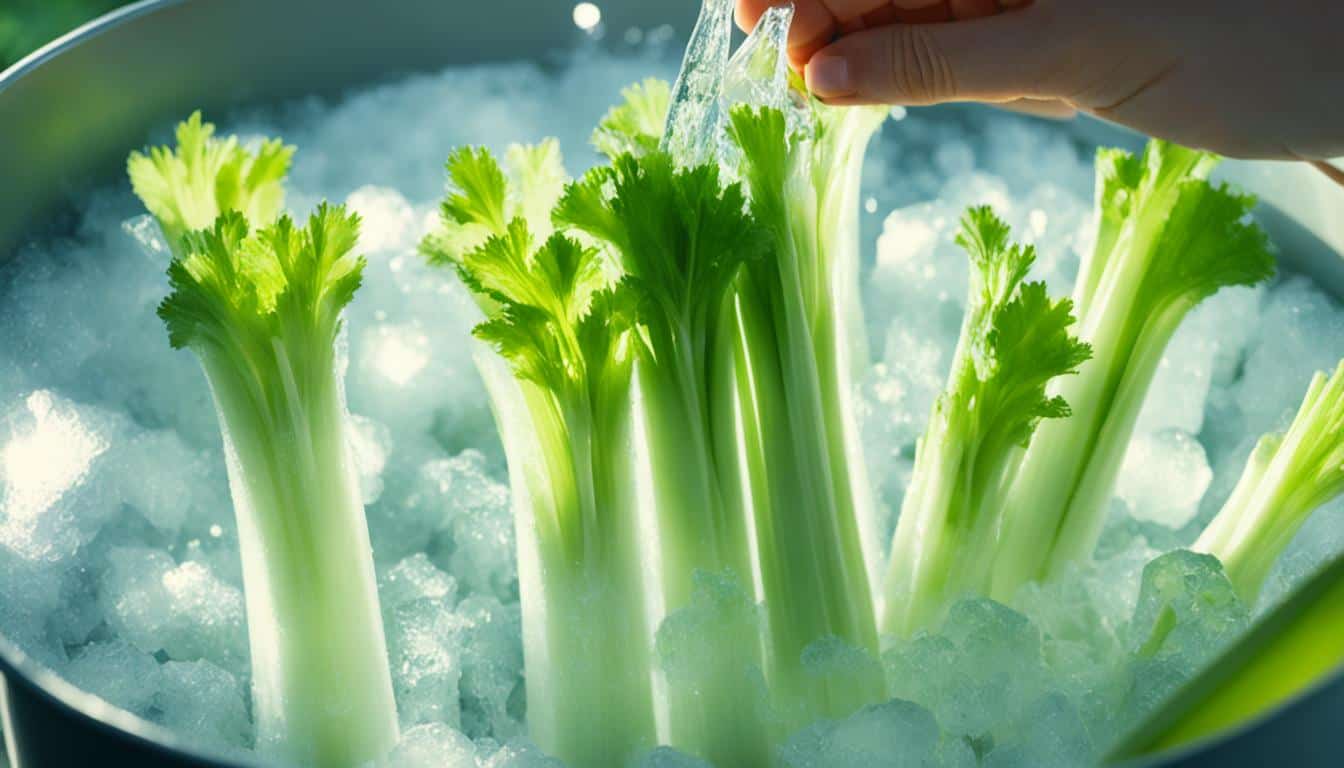

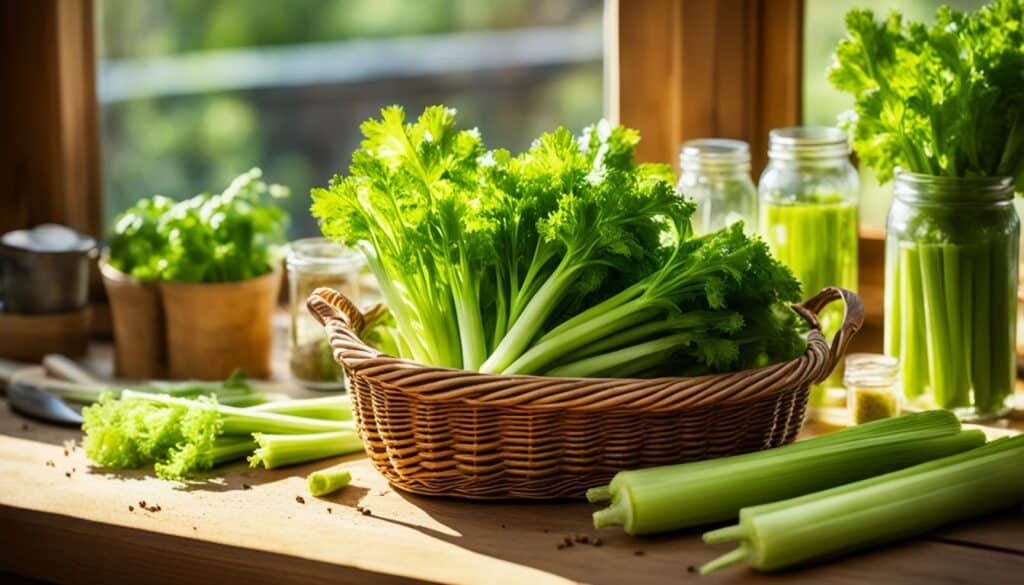

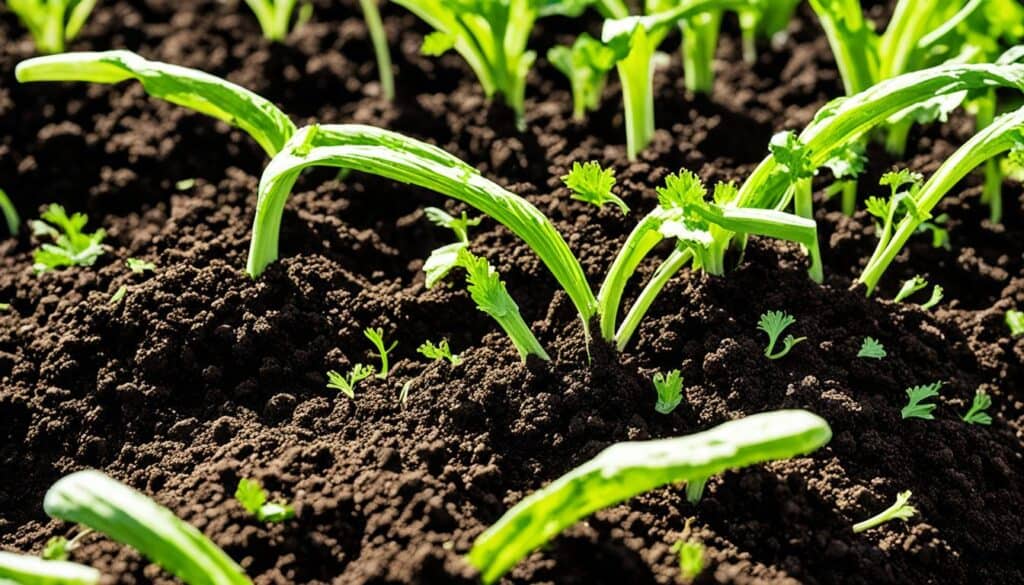
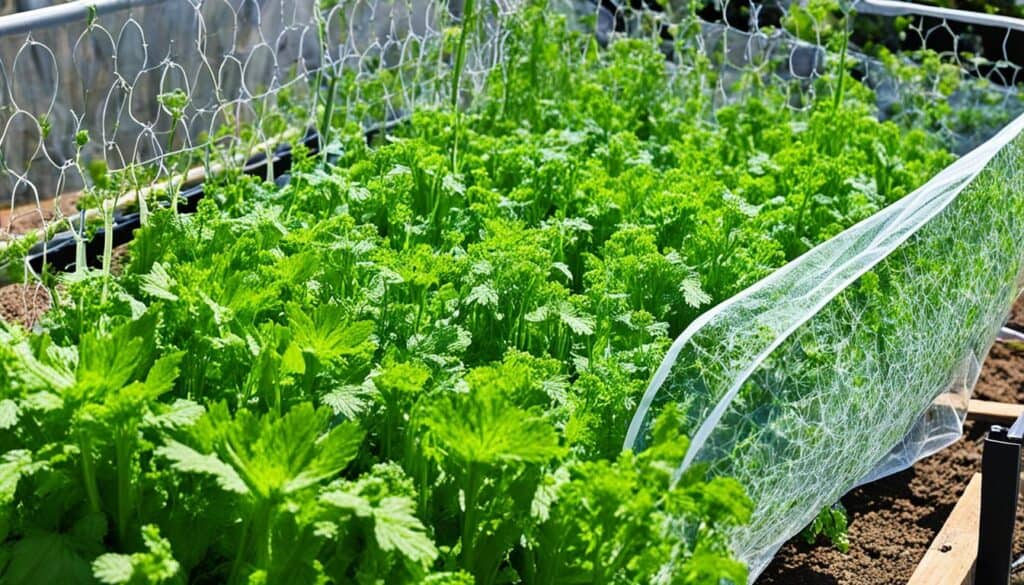


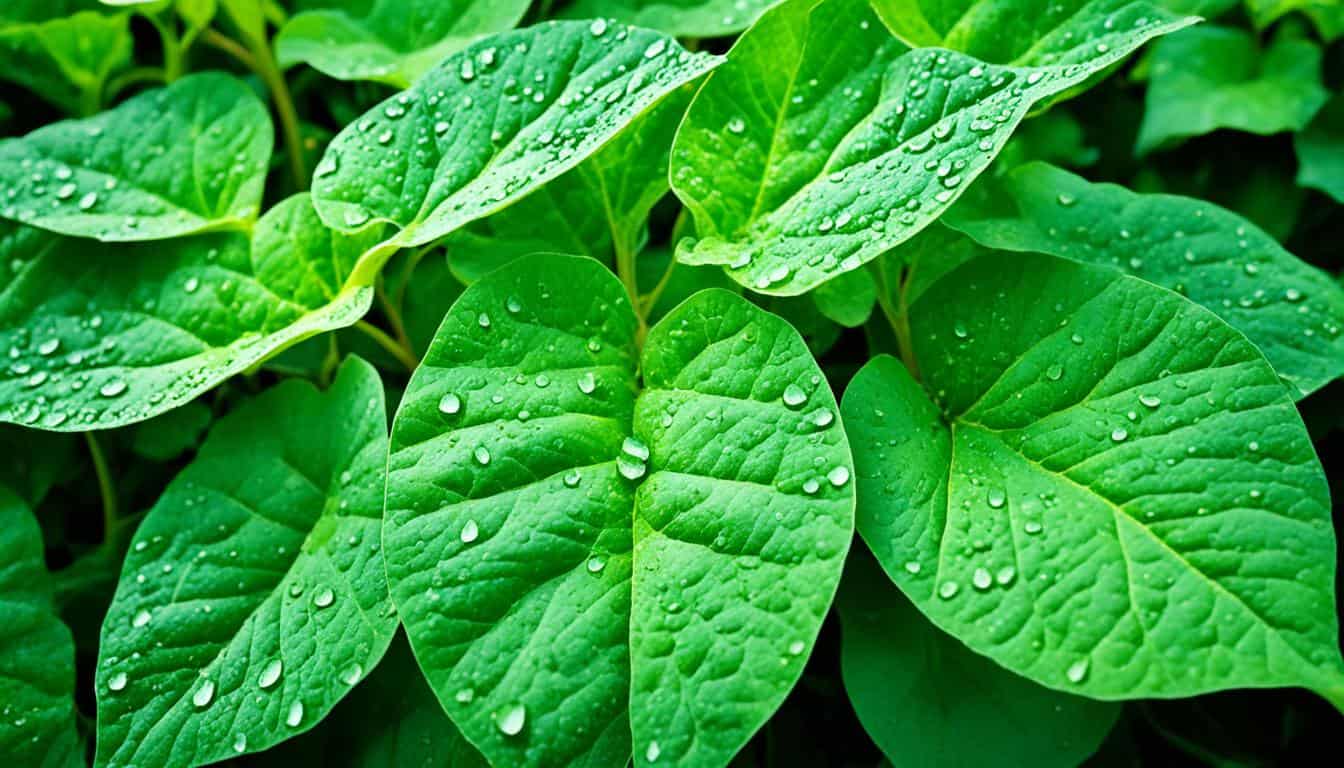
Leave a Reply